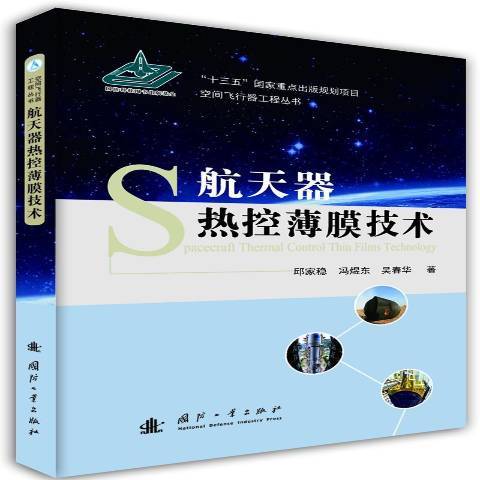內容簡介
本書介紹了當今太空飛行器熱控薄膜技術的發展水平,特別是詳細介紹了我國在太空飛行器熱控薄膜研究方面的新技術和新產品。
全書共分為7章。第1章概括地介紹了太空飛行器熱控薄膜相關的基本知識和物理基礎。第2至第5章介紹了太空飛行器常用的熱控薄膜材料和器件,主要包括單一結構被動熱控薄膜材料、複合結構被動熱控薄膜材料、智慧型型熱控薄膜材料和微結構熱控薄膜器件的工作原理和套用情況。第6章介紹了太空飛行器常用熱控薄膜材料的製備技術、表征方法和性能檢測技術。第7章對熱控薄膜的常規地面試驗、單一空間環境試驗和綜合輻照試驗進行了介紹。
本書內容新穎,實用性強,適合從事熱控薄膜技術相關工作的工程技術人員和科研人員使用,亦可供大專院校相關專業的師生閱讀。
The book introduces development of spacecraft thermal control thin films technologies nowadays,especially the detail of new technologies and new products of thermal control thin films developed in China.
The book consists of 7 chapters.Chapter 1 summarizes fundamental knowledge and physical basis of spacecraft thermal control thin films.From Chapter 2 to Chapter 5,frequently used spacecraft thermal control thin films and devices are introduced,including principles and applications of passive thermal control thin films with single structure,passive thermal control thin films with composite structures,intelligent thermal control thin films and microstructure thermal control thin film devices.Chapter 6 introduces preparation,characterization and detection techniques in common use for spacecraft thermal control thin films.Chapter 7 introduces general ground test,single simulative space environmental test and combined irradiation test for thermal control thin films.
The content of this book is novel and practical.This book is suitable for engineering technicists and scientific researchers who are engaged in thermal control thin film technology,and can also be read by college teachers and students of relative specialty.
圖書目錄
第1章艦用鍋爐的基本結構和工作過程
1.1艦用鍋爐的分類、用途和要求
1.1.1艦用鍋爐的分類和用途
1.1.2艦用鍋爐的要求
1.1.3艦用鍋爐材料及其要求
1.2艦用蒸汽鍋爐的基本結構和工作過程
1.2.1艦用自然循環蒸汽鍋爐
1.2.2艦用直流式蒸汽鍋爐
1.2.3艦用強制循環蒸汽鍋爐
1.2.4艦用蒸汽鍋爐的工作過程
1.3艦用蒸汽鍋爐的特性
第2章燃油及其燃燒產物
2.1艦用鍋爐用燃油及其特性
2.1.1艦用鍋爐用燃油
2.1.2燃油的物理化學特性
2.2燃油燃燒所需的空氣量
2.2.1可燃元素燃燒所需氧量和產生的產物量
2.2.2理論空氣量
2.2.3實際空氣量和空氣過余係數
2.3燃燒產生的煙氣量
2.3.1設計熱力計算
2.3.2煙氣分析
2.3.3校核熱力計算
2.4空氣和煙氣的焓
2.4.1空氣焓
2.4.2煙氣焓
第3章燃燒原理及燃燒設備
3.1燃燒的化學反應動力學基礎
3.1.1化學反應速度及質量作用定律
3.1.2阿累尼烏斯定律及活化能
3.1.3影響化學反應速度的主要因素
3.1.4鏈鎖反應
第1章概論
1.1太空飛行器熱控與熱控薄膜
1.2熱控薄膜的分類與特點
1.2.1熱控薄膜的定義
1.2.2熱控薄膜的特點
1.2.3熱控薄膜的分類
1.3熱控薄膜技術相關理論與熱控原理
1.3.1熱控薄膜的熱控性能參數
1.3.2紅外發射率基礎理論
1.3.3熱控薄膜材料的控溫原理
1.4熱控薄膜的空間環境適應性
1.4.1熱環境對熱控薄膜的要求
1.4.2電磁輻照環境對熱控薄膜的要求
1.4.3空間粒子輻照對熱控薄膜的要求
1.4.4原子氧環境對熱控薄膜的要求
第2章單一結構被動熱控薄膜
2.1聚醯亞胺鍍鍺膜熱控薄膜
2.1.1基本概念
2.1.2研究進展
2.1.3發展趨勢
2.2多層隔熱反射屏熱控薄膜
2.2.1基本概念
2.2.2研究進展
2.3SiO2熱控薄膜
2.3.1基本概念
2.3.2研究進展
2.3.3發展趨勢
2.4TiAlN熱控薄膜
2.4.1基本概念
2.4.2研究進展
2.4.3發展趨勢
2.5高熱導金剛石薄膜
2.5.1基本概念
2.5.2研究進展
2.5.3發展趨勢
2.6黑色熱控薄膜
2.6.1基本概念
2.6.2研究進展
2.6.3發展趨勢
2.7單一結構熱控薄膜的優缺點及適用性
第3章複合結構被動熱控薄膜
3.1玻璃型二次表面鏡
3.1.1基本概念
3.1.2研究進展
3.1.3發展趨勢
3.2柔性二次表面鏡
3.2.1基本概念
3.2.2研究進展
3.2.3發展趨勢
3.3金屬-陶瓷(介質)複合熱控薄膜
3.3.1基本概念
3.3.2研究進展
3.3.3發展趨勢
3.4CCAg光學多層複合熱控薄膜
3.4.1基本概念
3.4.2研究進展
3.4.3發展趨勢
3.5複合結構被動熱控薄膜的優缺點及適用性
第4章智慧型型熱控薄膜
4.1二氧化釩智慧型型熱控薄膜
4.1.1基本概念
4.1.2研究進展
4.1.3發展趨勢
4.2稀土錳氧化物摻雜智慧型熱控薄膜
4.2.1稀土錳氧化物摻雜材料基本概念
4.2.2研究進展
4.2.3發展趨勢
4.3電致變色熱控器件
4.3.1基本概念
4.3.2研究進展
4.3.3發展趨勢
4.4智慧型型熱控薄膜的優缺點及適用性
第5章微結構熱控薄膜器件
5.1MEMS熱控百葉窗
5.1.1基本概念
5.1.2微型熱控百葉窗國內外研究現狀
5.1.3扭轉式微型熱控百葉窗結構設計
5.1.4扭轉式微型熱控百葉窗材料選擇
5.1.5扭轉式微型熱控百葉窗的機電特性的理論分析
5.1.6扭轉式微型熱控百葉窗有限元仿真模擬
5.1.7仿真分析結果與解析計算結果對比
5.1.8微型熱控百葉窗原理樣件研製
5.1.9微型熱控百葉窗發展趨勢
5.2微型熱開關輻射器
5.2.1基本概念
5.2.2國內外研究現狀
5.2.3微型熱開關輻射器設計
5.2.4微型熱開關輻射器驅動電壓計算
5.2.5仿真分析
5.2.6微型熱開關輻射器熱性能理論分析
5.2.7微型熱開關輻射器製備
5.2.8發展趨勢
5.3薄膜電加熱器
5.3.1基本概念
5.3.2研究進展
第6章熱控薄膜製備、表征與檢測
6.1熱控薄膜製備
6.1.1真空蒸鍍技術
6.1.2磁控濺射技術
6.1.3微波CVD技術
6.1.4溶膠-凝膠法
6.1.5原子層沉積技術
6.1.6熱控薄膜製備方案的選擇及關鍵技術途徑
6.2熱控薄膜表征
6.2.1薄膜材料的晶體結構分析
6.2.2薄膜材料的微觀結構分析
6.2.3薄膜材料的化學組成分析
6.2.4薄膜材料的光學性能分析
6.2.5薄膜材料的電學性能分析
6.3熱控薄膜檢測
6.3.1薄膜材料熱導率檢測技術
6.3.2太陽吸收率檢測技術
6.3.3紅外發射率檢測技術
第7章熱控薄膜試驗技術
7.1地面環境試驗
7.1.1熱控薄膜濕熱試驗
7.1.2熱控薄膜附著力試驗
7.2單一模擬空間環境試驗
7.2.1真空-紫外輻照試驗
7.2.2真空-質子輻照試驗
7.2.3真空-電子輻照試驗
7.2.4原子氧試驗
7.2.5熱真空試驗
7.2.6充放電試驗
7.3綜合模擬空間環境試驗
參考文獻
CONTENTS
Chapter 1Introduction
1.1Spacecraft thermal control and thermal control thin films
1.2Classification and properties of thermal control thin films
1.2.1Definition of thermal control thin films
1.2.2Properties of thermal control thin films
1.2.3Classification of thermal control thin films
1.3Theories and principles of thermal control thin film technology
1.3.1Thermal control parameters of thermal control thin films
1.3.2Theories of infrared emissivity
1.3.3Thermal control principles of thermal control thin films
1.4Space environmental adaptability of thermal control thin films
1.4.1Thermal control requirement for thermal control
thin films
1.4.2Eletromagnetic radiation protection requirement for
thermal control thin films
1.4.3Space particle irradiation protection requirement for
thermal control thin films
1.4.4Atomic oxygen protection requirement for thermal
control thin films
Chapter 2Passive thermal control thin films with single structure
2.1Germanium coated polyimide thermal control thin film
2.1.1Basic concept
2.1.2Research progress
2.1.3Trend in development
2.2Multilayer heat insulation reflective plate thermal control
thin film
2.2.1Basic concept
2.2.2Research progress
2.3Silicon dioxide thermal control thin film
2.3.1Basic concept
2.3.2Research progress
2.3.3Trend in development
2.4TiAlN thermal control thin film
2.4.1Basic concept
2.4.2Research progress
2.4.3Trend in development
2.5High heat conductivity diamond thermal control thin film
2.5.1Basic concept
2.5.2Research progress
2.5.3Trend in development
2.6High absorptivity thermal control thin film
2.6.1Basic concept
2.6.2Research progress
2.6.3Trend in development
2.7Properties and applicability of passive thermal control thin films
with single structure
Chapter 3Passive thermal control thin films with composite
structures
3.1Glass second surface mirror
3.1.1Basic concept
3.1.2Research progress
3.1.3Trend in development
3.2Flexible second surface mirror
3.2.1Basic concept
3.2.2Research progress
3.2.3Trend in development
3.3Metal-ceramic(dielectric) composite thermal control thin film
3.3.1Basic concept
3.3.2Research progress
3.3.3Trend in development
3.4CCAg optical multilayer composite thermal control thin film
3.4.1Basic concept
3.4.2Research progress
3.4.3Trend in development
3.5Properties and applicability of passive thermal control thin films
with composite structures
Chapter 4Intelligent thermal control thin films
4.1Vanadium dioxide intelligent thermal control thin film
4.1.1Basic concept
4.1.2Research progress
4.1.3Trend in development
4.2Rare earth manganese oxide doped intelligent thermal control
thin film
4.2.1Basic concept of rare earth manganese oxide doped
materials
4.2.2Research progress
4.2.3Trend in development
4.3Electrochromic thermal control device
4.3.1Basic concept
4.3.2Research progress
4.3.3Trend in development
4.4Properties and applicability of intelligent thermal control
thin films
Chapter 5Microstructure thermal control thin film devices
5.1MEMS thermal control louvers
5.1.1Basic concept
5.1.2Research status of MEMS thermal control louvers at home
and abroad
5.1.3Configuration design of torsion type MEMS thermal control
louvers
5.1.4Material selection of torsion type MEMS thermal control
louvers
5.1.5Theoretical analysis of electromechanical characteristics for
torsion type MEMS thermal control louvers
5.1.6Finite element simulation of torsion type MEMS thermal
control louvers
5.1.7Comparison of finite element simulation and analytic
calculation
5.1.8Principled sample preparation of MEMS thermal control
louvers
5.1.9Trend in development of MEMS thermal control louvers
5.2Minitype thermal switch radiator
5.2.1Basic concept
5.2.2Research status at home and abroad
5.2.3Design of minitype thermal switch radiator
5.2.4Drive voltage calculation of minitype thermal switch
radiator
5.2.5Simulation of minitype thermal switch radiator
5.2.6Theoretical analysis of heat characteristics for minitype
thermal switch radiator
5.2.7Preparation of minitype thermal switch radiator
5.2.8Trend in development
5.3Thin film electric heater
5.3.1Basic concept
5.3.2Research progress
Chapter 6Preparation, characterization and detection of thermal
control thin films
6.1Preparation of thermal control thin films
6.1.1Vacuum evaporation
6.1.2Magnetron sputtering
6.1.3Microwave CVD
6.1.4Sol-Gel
6.1.5Atomic layer deposition
6.1.6Preparation method selection and key technology of thermal
control films
6.2Characterization of thermal control thin films
6.2.1Crystal structure analysis of thin films
6.2.2Microstructure analysis of thin films
6.2.3Chemical composition analysis of thin films
6.2.4Optical performance analysis of thin films
6.2.5Electrical performance analysis of thin films
6.3Detection of thermal control thin films
6.3.1Thermal conductivity detection of thin films
6.3.2Solar absorption detection of thin films
6.3.3Infrared emissivity detection of thin films
Chapter 7Test technique for thermal control thin films
7.1Ground environmental test
7.1.1Damp heat test of thermal control thin films
7.1.2Adhesion test of thermal control thin films
7.2Simulative individual space environmental test
7.2.1Vacuum-ultraviolet irradiation test
7.2.2Vacuum-proton irradiation test
7.2.3Vacuum-electron irradiation test
7.2.4Atomic oxygen test
7.2.5Thermal vacuum test
7.2.6Charge-discharge test
7.3Combined irradiation test
Reference

